A vein of sentimental delicacy connotes Antonio Canova ’s (Possagno, 1757 Venice, 1822) masterpiece right from the title with which the Louvre has decided to present it to its public: Psyché ranimée par le baiser de l’Amour, or “Psyche Awakened by Love’s Kiss.” Not “Amore and Psyche lying,” as the work is known in Italy, or “Amore and Psyche embracing,” the designation by which Canova, in a December 12, 1801 letter to Antoine Chrysostome Quatremère de Quincy, had referred to the sculptural group. Rather than sensual impulses, which in any case are not dormant in Canova, the title in French prefers to emphasize the sweetness of the gesture, and at the same time intends to connote precisely the moment of the fable we are witnessing, although the Venetian sculptor’s interpretation is slightly different from the literary text to which it refers. It is therefore worth recounting the beautiful story of Cupid and Psyche that the poet Apuleius tells in his famous work, The Golden Ass, the only novel of Roman antiquity that we know in its entirety: the fable is a long digression that the reader encounters as the plot unfolds.
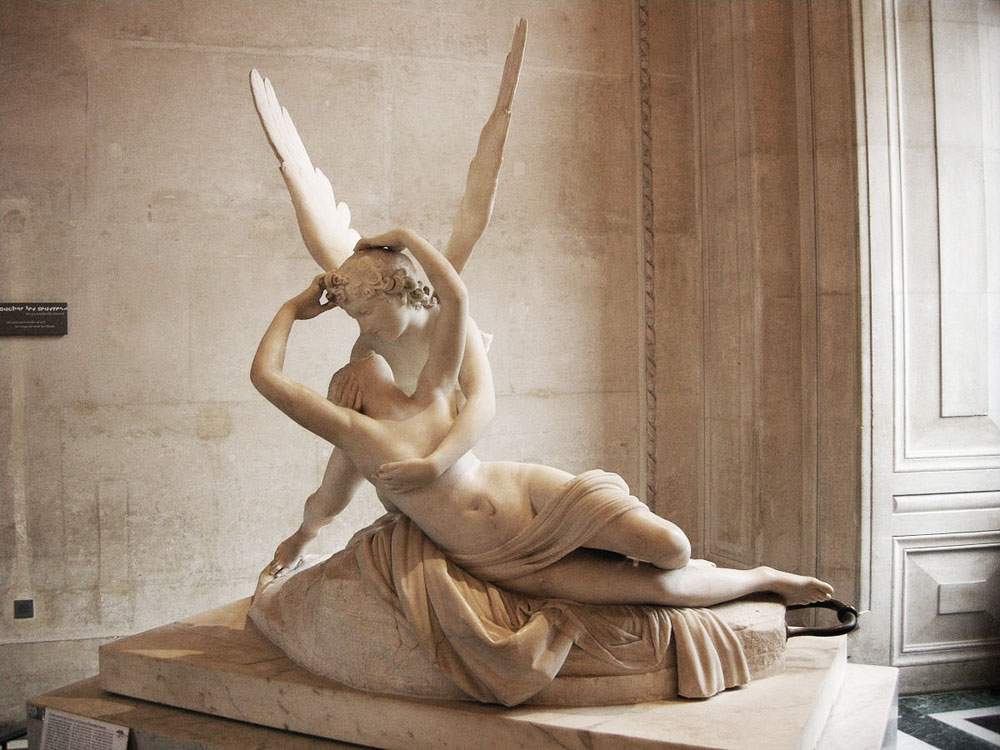 |
| Antonio Canova, Love and Psyche lying (1787-1793; marble, 155 x 168 x 101 cm; Paris, Louvre). Photo by Francesco Gasparetti - Credit |
Psyche is a beautiful girl whose loveliness arouses the curiosity and, at the same time, the jealousy of Venus: the many men in love with Psyche, in fact, have taken to comparing the young woman to the goddess of beauty. The latter, in order to punish her, decides to send her son, Amore, against her: the god’s arrows in fact have the power to make people fall in love, and the idea is to make Psyche fall in love with the ugliest man on the face of the earth. However, Amore makes the mistake of shooting the arrow, and ends up striking himself: he is therefore the one who falls madly in love with Psyche. But the young god cannot make his mother aware of the situation: in fact, Venus’ reaction would have very dangerous implications. Thus, Cupid arranges for Psyche to come to his palace: the god, continually concealing himself so as not to reveal his identity, succeeds in conquering her, and the two spend heated encounters of passion together, the likes of which no mortal woman had ever experienced. However, one night Psyche, on the advice of her envious sisters, decides to spy on her lover while he sleeps, in order to learn his identity. However, she does not reckon with her oil lamp: a drop slips from the lamp and ends up on Love’s skin, who wakes up and, disappointed and angry, abandons the girl.
Psyche is distraught with grief, tries in vain to kill herself, cannot find peace, and begins to wander the earth in search of Love: the solution, the girl thinks, is to turn to Venus, although she knows that the choice may cost her dearly. Venus, in fact, subjects Psyche to some very hard trials: the last of these consists of going to the underworld to ask the goddess Proserpina for a cruet containing some of her beauty. Psyche passes all the tests, goes to the underworld, manages to obtain the jar, but her curiosity leads her to open it: it turns out to be a trap of Venus, for the contents of the jar are a soporific air that throws her into a very deep sleep. Cupid, who in the meantime has begun to miss Psyche and has come to find her absence unbearable, rushes to his beloved’s rescue and, pricking her with an arrow, awakens her, scolding her because already for the second time her curiosity has risked being fatal to her. Love then flies to Jupiter to ask him for help: the father of the gods consents to theunion of the two, and the tale ends with the marriage, which enables Psyche to become a goddess.
The moment in the tale described by Canova is that of Psyche’s awakening after her infernal sleep: helping us to identify the precise instant is the jar that the girl brought back with her from the underworld, and which we notice behind her back. However, as anticipated, in Canova’s work Love does not awaken Psyche “innoxio punctulo sagittae suae” (i.e., “with a harmless prick of his arrow”), but with a languid kiss. Recalling the motivations that prompted Canova to give his own interpretation of the fable told by Apuleius is Leopoldo Cicognara (Ferrara, 1767 Venice, 1834), an art historian and friend of the Venetian sculptor, who in his History of Sculpture, published between 1813 and 1818, writes that the “not so simple and innocent” way in which Canova treated the subject “had no other origin than from an observation made to the artificer by milord Bristol, to whom the seated Theseus seemed cold; whence he proposed to make a work of a very warm and passionate character.” The personage mentioned by Cicognara, Fredrick Augustus Hervey, fourth Earl of Bristol, had been a client of Canova’s, and according to the above reconstruction he had the merit of having stimulated in the artist the desire to treat his subjects with greater passion: hence the reason for that warm kiss that Cupid gives to Psyche to awaken her from her sleep.
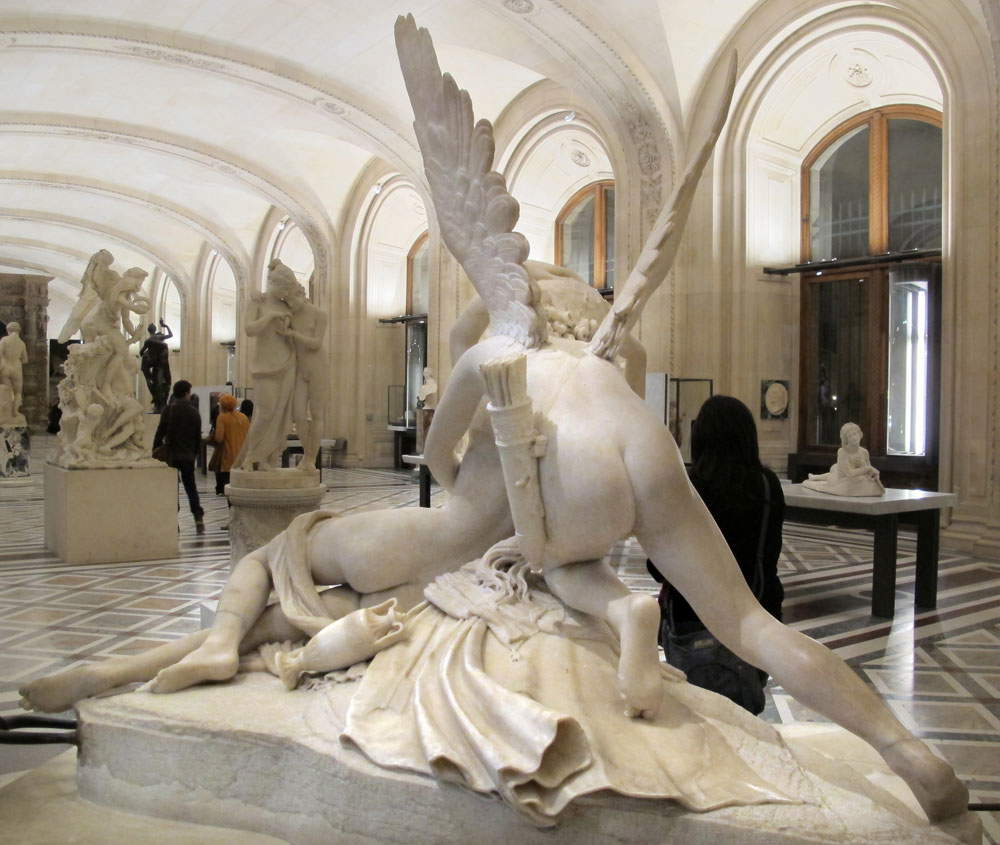 |
| The group seen from behind. Photo by Francesco Gasparetti - Credit |
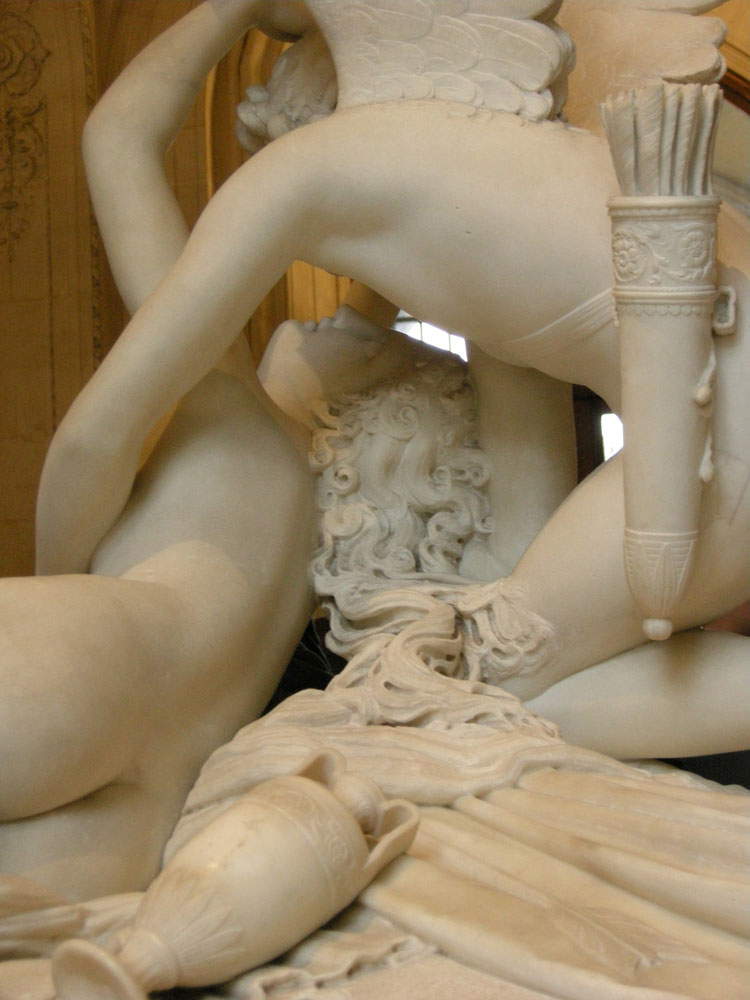 |
| Detail with the vase and arrows. Photo by Francesco Gasparetti - Credit |
There would be a definite iconographic precedent from which Canova would have been inspired to make the group. In particular, the critic Karl Ludwig Fernow (who was always particularly hard on the Venetian artist) had noted how Canova had drawn inspiration from a painting with Faun and Bacchante from Herculaneum (which in turn had inspired an engraving by Filippo Morghen that would constitute another important precedent): it is, after all, well known that Canova, on the occasion of his stay in Naples in 1780 (a stay later repeated in 1787, the same year in which he received the commission for Amore e Psiche giacenti), had the opportunity to visit the ruins of Herculaneum, as well as those of Pompeii and Paestum, but it is equally likely that Morghen himself had been his “conduit” with the ancient painting. Inspiration, however, may also have come from other sources: for example, a painting by Jacopo Amigoni, a Venetian artist like Canova, which depicts Flora and Zephyrus in an attitude that may vaguely recall that assumed by Amore and Psyche in the Possagno sculptor’s group. Or again, a possible source, identified by Gian Lorenzo Mellini, could be a porcelain from the Ludwigsburg manufactory, modeled by Christian Wilhelm Beyer and reproduced in several examples, which depicts a nymph with a faun embracing each other.
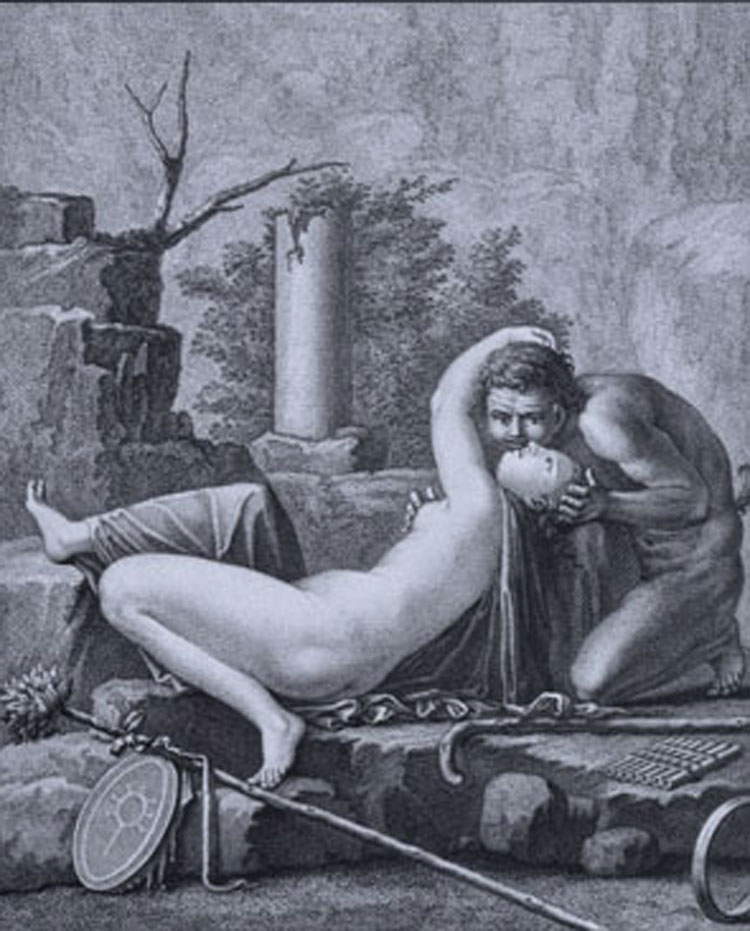 |
| Filippo Morghen, Faun and Bacchante (1757; engraving from the book Le pitture Antiche d’Ercolano, vol. I pl. XV; Paris, Bibliothèque Nationale de France) |
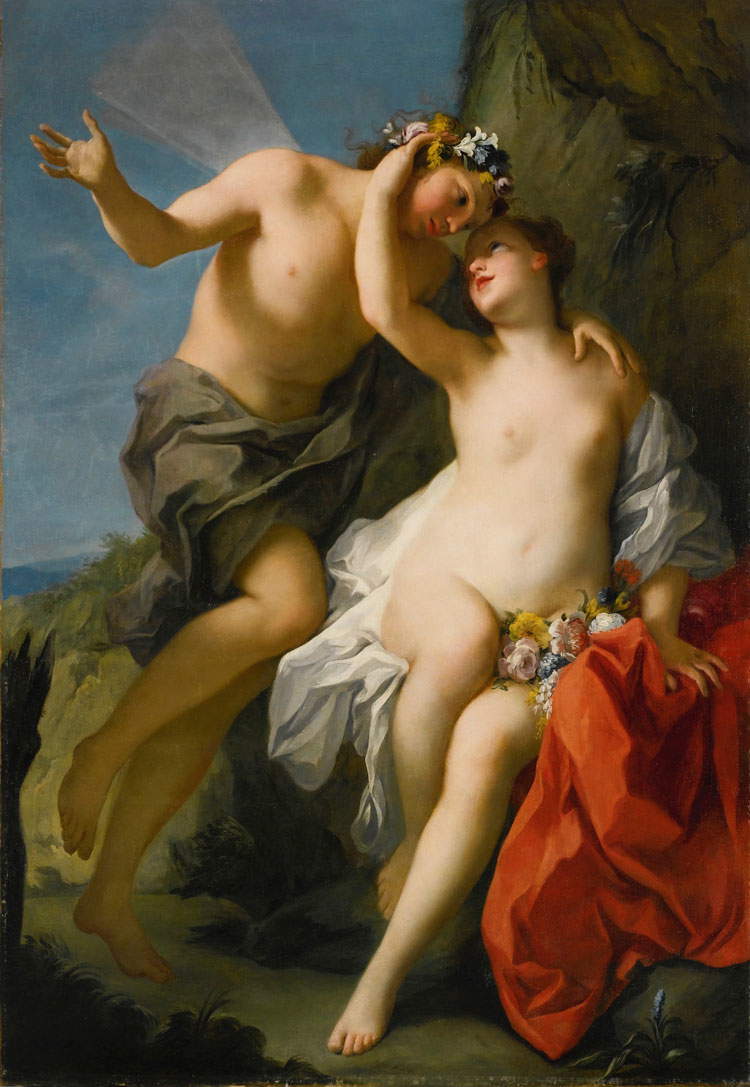 |
| Jacopo Amigoni, Flora and Zephyrus (c. 1725-1735; oil on canvas, 157.5 x 109.3 cm; Private collection). The painting went to auction at Sotheby’s in 2014. |
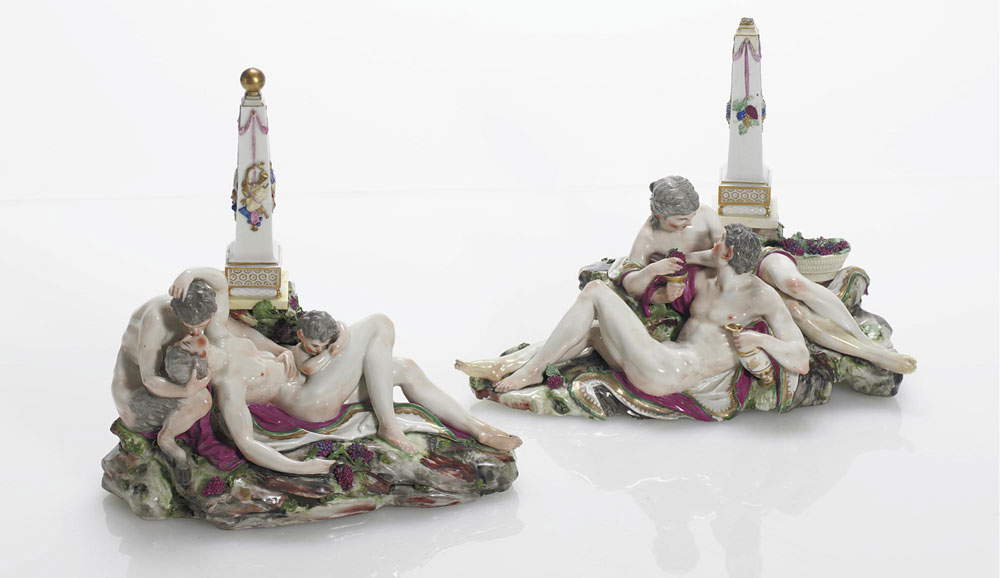 |
| Ludwigsburg Manufacture based on a model by Christian Wilhelm Beyer and Johann Adam Bauer, Pair of Bacchanalian Scenes (c. 1770; porcelain, 26 cm long; Private Collection). The pair went to auction at Sotheby’s in 2007. |
Certainly the study of the group was particularly laborious, as the drawings and terracotta sketches that have been preserved attest: evidence that, moreover, also helps us in the task of discerning iconographic sources. There is in particular a sheet, preserved in the Museo Civico of Bassano del Grappa (inventory E.b. 172.1183), where, in the upper right corner, there appears a sketch with two lying figures that seem to trace Morghen’s engraving from the book Le pitture antiche d’Ercolano: the raised arm of the woman, a motif that returns in all the studies for Amore e Psiche giacenti, is the one that we will later find in the finished sculpture as well. There is also a terracotta sketch, conserved at the Museo Correr in Venice, which represents a later moment in the elaboration of the group, although the dependence on the ancient model is still evident. It is clear, however, that Canova already had in mind that the scene should have a certain erotic connotation, such as that which transpires from this sketch, which seems to represent more the beginning of an embrace than a kiss between two mythological characters. The idea seems by now to be almost entirely fixed in a further drawing, also preserved in Bassano (inventory E.b. 29.1040), in which a pose almost entirely identical to that of the finished group is outlined: Psyche is lying down, with her back slightly raised, and she stretches her arms toward the neck of Cupid. Her lover emerges from behind, wings outstretched, one leg bent to rest on his knee and the other outstretched, as he reaches out toward his beloved to give her a kiss.
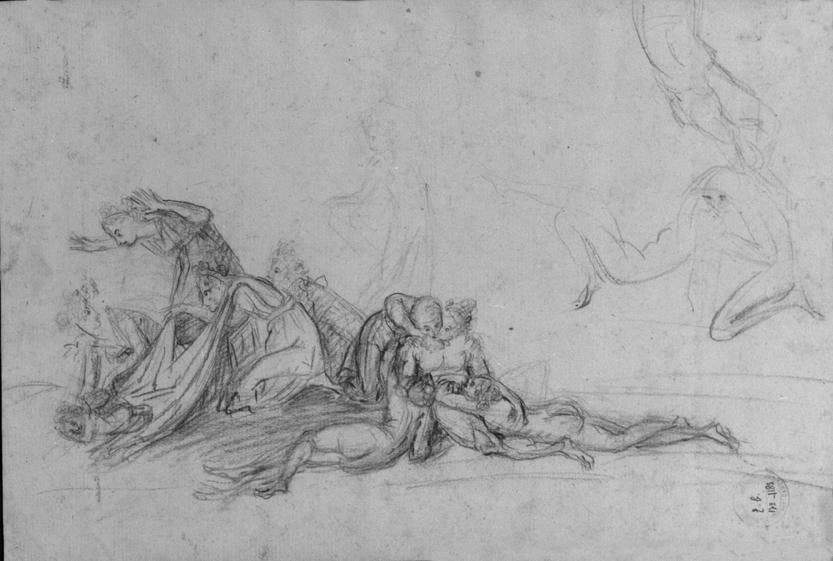 |
| Antonio Canova, Nymphs Discovering Cupid and Other Grouped Figures (1787; charcoal drawing on paper, 22 x 32.9 cm; Bassano del Grappa, Museo Civico, Gabinetto dei Disegni e delle Stampe) |
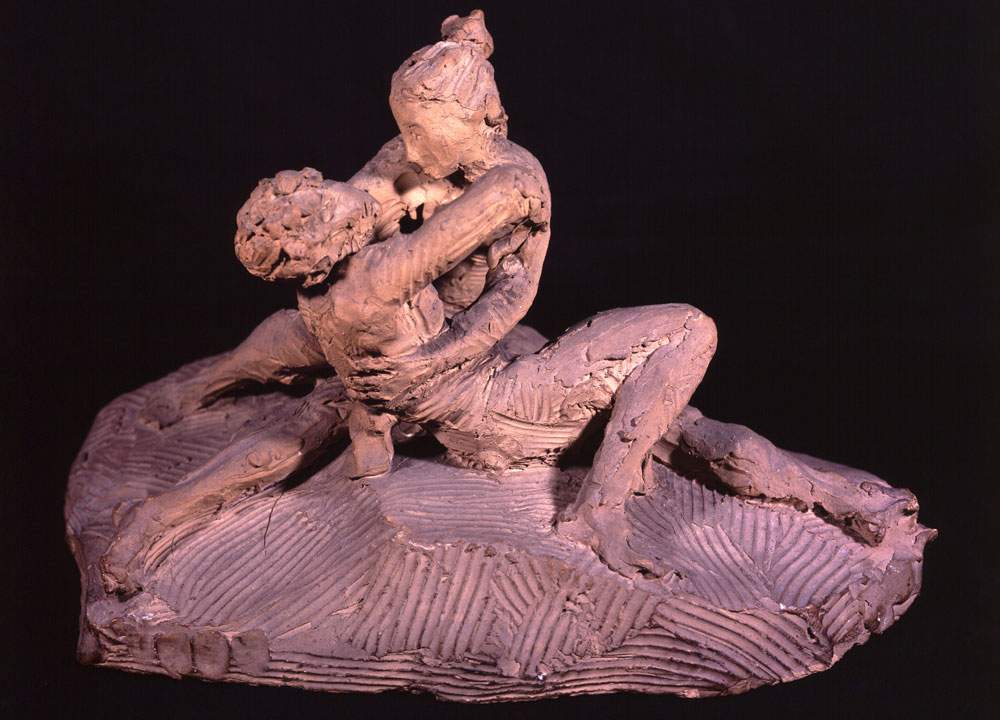 |
| Antonio Canova, Sketch for Amore e Psiche giacenti (1787; terracotta, height 25 cm; Venice, Museo Correr) |
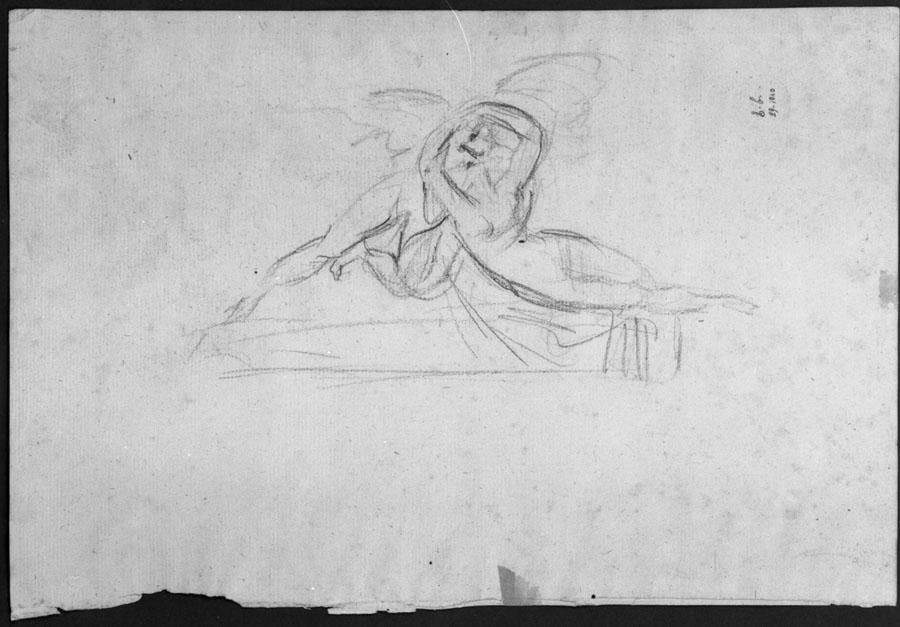 |
| Antonio Canova, Amore e Psiche g iacenti (1787; fat pencil drawing on paper, 19.5 x 33.5 cm; Bassano del Grappa, Museo Civico, Gabinetto dei Disegni e delle Stampe) |
The creative process was already finished by 1788, the year in which Canova had prepared two plaster casts from which he would make the finished work in Carrara marble. The patron was an English nobleman, John Campbell (who became, in 1796, the first Baron of Cawdor), but he would never come into possession of the marble: Canova finished the work in 1793, and at that time Campbell, for reasons not yet fully clarified, could not finish paying for it. The group thus remained in the sculptor’s studio until 1798, when a certain “Dutch Henry Hoppe” (Hugh Honour, a great scholar of Canova, identifies him as Henry Philip Hope, a member of an Anglo-Dutch banking family) offered for the work the sum of two thousand zecchini: the same with which at a very short distance, that is, in 1800, the sculpture was sold to Joachim Murat, who installed it in his residence, the castle of Villiers-la-Garenne, where Napoleon also had the opportunity to admire it. The work was then moved to the Palace of Compiègne and, after Murat became king of Naples, was finally transferred to the Louvre, where it can still be seen today.
The work aroused admiration on the part of many, not least because of the composition, which, while laying its solid foundations on older examples, arrived at its own peculiar originality (not least because never in marble had such a special composition been seen), the result of an inventive imagination that was always very fervent in Canova. Even the aforementioned Cicognara noted the novelty of the attitude, and certainly Canova’s sculpture is also an admirable example of compositional wisdom, with the bodies crossing each other on two soft diagonals that give balance to the whole and intersect in one of the most admired points of the sculpture, namely Love’s arm covering Psyche’s breast. And again, it is impossible not to praise the arms of the young woman, raised to form a circle that frames Love’s face, or the circle that Love in turn creates by encircling the body of his beloved, and which goes to intertwine with the one created by her arms: a complexity such as to offer multiple points of view to the observer, and which allow Canova to go beyond, as a distinguished art historian such as Giuliano Briganti had to write, “that iconic fixity,” “that statuesque rigidity closed in the two visions, frontal and in profile,” and “that typological absolute to which Thorvaldsen tended.” Suffice it to say that, in order to spot Psyche’s vase and Love’s arrows, it is necessary to go around the statue and see it from behind: otherwise it is impossible to discern the two elements.
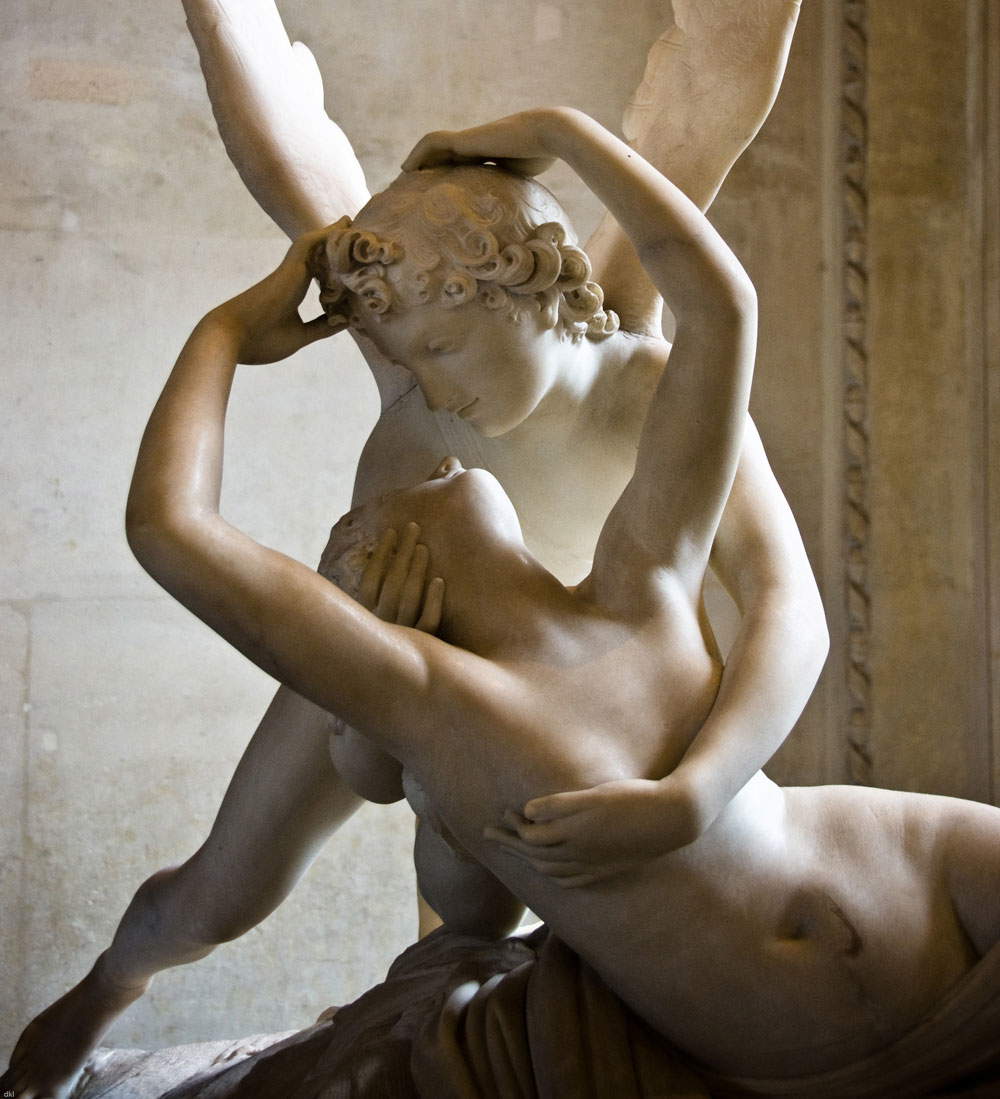 |
| The circles drawn by the arms of Cupid and Psyche. Credit |
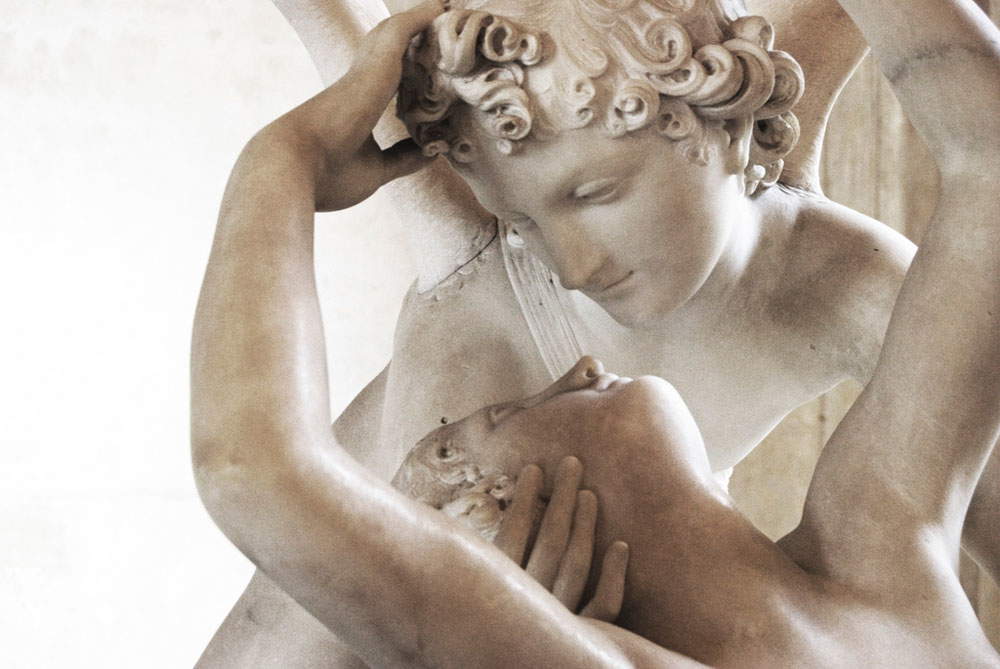 |
| Detail of the faces. Photo by Joseph Kranak - Credit |
A sculptor who was a pupil of Canova, Antonio D’Este, in his Memoirs thus recalled the group: “Amore then the toe of his right foot on the extreme edge resting, and holding himself on the left knee that rests toward the end of the stone, encircles with his amplexes his tender friend, and with his left arm presses her not yet ripe breast, divided in such a way that with that he lays in passing on the inferior part of her left breast, and picks it up, and lightly supports her right hand. In a similar act he bends his forehead somewhat, and with a half-smile of the lower lip, which protrudes part way out, he seems close to laying a kiss on the beloved semblance, while he with his right hand supports the head of Psyche, from which scattered and errant the disheveled manes descend.” However, Antonio D’Este could not help but notice that “the author made this group honest” (where by “honest” we must mean “chaste”), “because the embrace of Cupid with his beloved maiden is so innocent and chaste, that it does not leave one to form thoughts less than honest.” In fact we have seen how Cicognara already considered the way in which Canova depicted the two characters not so “innocent,” and we have also seen how some cues came to him from ancient scenes of eroticism. It is precisely this sensuality that transpires from the work (as well as from other Canova achievements) that more recent critics have focused on. The embrace between Cupid and Psyche implies a refined and hinted eroticism, which communicates more an idea of tender sentiment than of impulsive desire, and which is also mitigated by the adolescent features of the two protagonists, but nevertheless refers to a sensual dimension through which, with elegance, all thelove between the god and his beloved is expressed. It is that “refined sensuality without eagerness” of which Mario Praz spoke in one of his essays and which represents one of the characteristic traits of Canova’s sculpture: an eroticism that, though controlled, differentiates the Venetian sculptor from so many of his colleagues (such as Bertel Thorvaldsen) who sought to totally repress all sensual motion.
Countless were the legions of admirers the sculpture had from the moment it was finished. One of the many, Prince Nikolai Jusupov, was so captivated by the work that he ordered a replica from Canova: it is the one that can be seen today in the Hermitage in St. Petersburg. But many were the artists, literary men and poets who sang the praises of Love and Psyche lying, or composed lyrics that were inspired by the sculpture, or intended to celebrate it. Worthy of all is perhaps the most passionate example of admiration for Canova’s work, namely that of Gustave Flaubert. The famous writer was at Villa Carlotta in Tremezzo: the owner, the nobleman and art collector Giovanni Battista Sommariva, had asked one of Canova’s best followers, Adamo Tadolini, for a copy of the Canova group, and once he received it, he set it up in his own home. Flaubert saw it, and he described his encounter with the work in his Voyage en Italie et Suisse: Qu’on me la perdonne, ç’a été depuis longtemps mon seul baiser sensuel; il était quelque chose plus encore, j’embrassais la beauté elle-même (“Forgive me: for a long time this has been my only sensual kiss; indeed, it has been something more: I have embraced beauty in person.”).
Reference Bibliography
Warning: the translation into English of the original Italian article was created using automatic tools. We undertake to review all articles, but we do not guarantee the total absence of inaccuracies in the translation due to the program. You can find the original by clicking on the ITA button. If you find any mistake,please contact us.